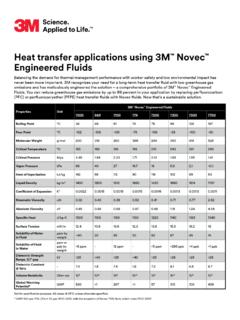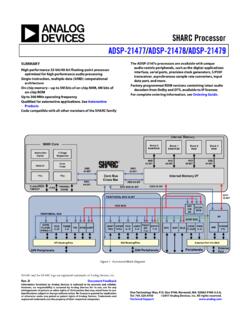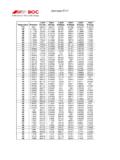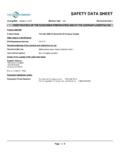Transcription of Refractive error blindness - WHO
1 Refractive error blindnessRakhi Dandona1& Lalit Dandona2 Recent data suggest that a large number of people are blind in different parts of the world due to high refractiveerror because they are not using appropriate Refractive correction. Refractive error as a cause of blindness has beenrecognized only recently with the increasing use of presenting visual acuity for defining blindness . In addition toblindness due to naturally occurring high Refractive error , inadequate Refractive correction of aphakia after cataractsurgery is also a significant cause of blindness in developing countries.
2 blindness due to Refractive error in anypopulation suggests that eye care services in general in that population are inadequate since treatment of refractiveerror is perhaps the simplest and most effective form of eye care. Strategies such as vision screening programmesneed to be implemented on a large scale to detect individuals suffering from Refractive error blindness . Sufficientnumbers of personnel to perform reasonable quality refraction need to be trained in developing countries. Alsoadequate infrastructure has to be developed in underserved areas of the world to facilitate the logistics of providingaffordable reasonable-quality spectacles to individuals suffering from Refractive error blindness .
3 Long-term successin reducing Refractive error blindness worldwide will require attention to these issues within the context ofcomprehensive approaches to reduce all causes of avoidable : Refractive errors /complications/etiology; Amblyopia/etiology (source: MeSH).Mots cle s:Troubles re fraction oculaire/complication/e tiologie; Amblyopie/e tiologie (source: INSERM).Palabras clave:Errores de refraccio n/complicaciones/etiolog a; Amblyopia/etiolog a (fuente: BIREME).Bulletin of the World Health Organization, 2001,79: 237 page 242 le re sume en franc ais.
4 En la pa gina 242 figura un resumen en espan error as a cause of blindness has notreceived muchattention because many definitions ofblindnesshavebeenbasedonbest-corrected distancevisual acuity, including the definition used in theInternationalStatisticalClassificatio nofDiseasesandRelatedHealthProblems(1).H owever,inmanypartsof the world Refractive error would become thesecond largest cause oftreatableblindness aftercataract if blindness were defined on the basis ofpresenting distance visual acuity (2 10).
5 Refractiveerrorisalsooneofthemostcommonc ausesofvisualimpairment (3 5,9 13).Because of the increasing realization of theenormous need for correction of Refractive errorworldwide,thisconditionhasbeenconsi deredoneoftheprioritiesoftherecentlylaun chedglobalinitiativefor the elimination of avoidable blindness : VISION2020 The Right to Sight (14,15). For the mostpart, Refractive error can be easily corrected withspectacles, which makes it imperative that effectivestrategies be developed to eliminate this easilytreatable cause of revie wpresents a summary of the currentand likely future issues related to blindness due torefractive of blindnessBlindnessisdefined eitherintermsofbest-correcteddistancevis ualacuity(themostappropriaterefractiveco rrection) or presenting distance visual acuity (theindividual s current Refractive correction)
6 In thebetter eye. The latter definition permits assessmentof blindness due to Refractive error , whereas on the prevalence of blindness in differentparts of the world (16), data on the prevalence ofblindness due to Refractive error are not readilyavailablebecausethepresentingdist ancevisualacuitydefinition is not always of importance in the definition ofblindness is the level of visual acuity that is acuity levels of <3/60 or < 6/60 in the bettereye have been commonly used to define blindness (2 9).
7 In addition, visual acuity levels <6/60 havesometimes been used to define blindness , forexample in the USA (10).1 Consultant, International Centre for Advancement of Rural Eye Care, Prasad Eye Institute, Banjara Hills, Hyderabad 500 034, India(email: and Doctoral Student, Centre forEye Research Australia, University of Melbourne, Melbourne, should be sent to this author at the former , International Centre for Advancement of Rural Eye Care, Prasad Eye Institute, Hyderabad, of the World Health Organization, 2001,79(3))
8 #World Health Organization 2001 Magnitude of Refractive errorblindnessWe carried out a literature search to identifyinformation from different parts of the world onthe magnitude of blindness due to Refractive errorfrom population-based surveys of blindness pub-lished in 1990 or later. The findings are summarizedin Table 1 (2 10).With blindness defined as a presentingdistance visual acuity < 3/60 in the better eye, (2) and India (7), for all age groups in thepopulation considered together. If blindness isdefined as presenting distance visual acuity <6/60in the better eye, the prevalence of blindness due torefractive error in an Indian population wasreported to be , including fromamblyopia resulting from high uncorrected refrac-tive error (7).
9 These data suggest that about 1 ofevery 280 people in the study population wereblind from uncorrected or inadequately correctedrefractive error or from Refractive high prevalence of Refractive error blindness ( ) was found among a population of Chineseover-50-years using the definition of presentingdistance visual acuity <6/60 in the better eye (8).With this definition, the prevalence of blindness dueto Refractive error among those aged >40 years in anIndianstudypopulationwasreportedtobequ itehigh( ) (7).
10 With blindness defined as a presentingvisual acuity <6/60 in the better eye, the prevalenceof Refractive error blindness in the USA amongindividuals aged >40 years has been reported among Blacks and among Whites (10).It must be kept in mind, however, that if only olderage groups are considered, the prevalence ofrefractive error blindness is likely to be higherbecause of cumulative effects, than that for all agegroups taken available data suggest that in India (7)andChina (8) blindness due to natural Refractive error ismore common than that due to aphakia, whereasblindness due to aphakia is more common in someAfrican countries (5,6).















